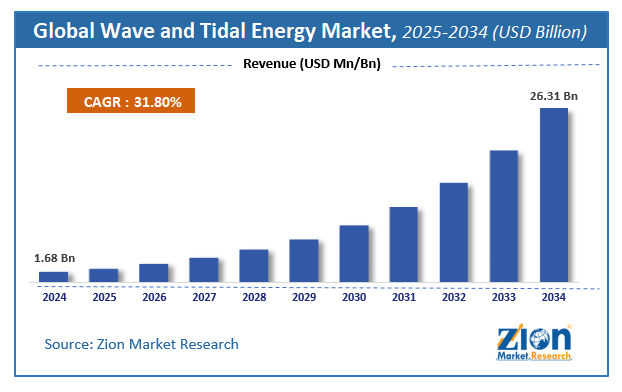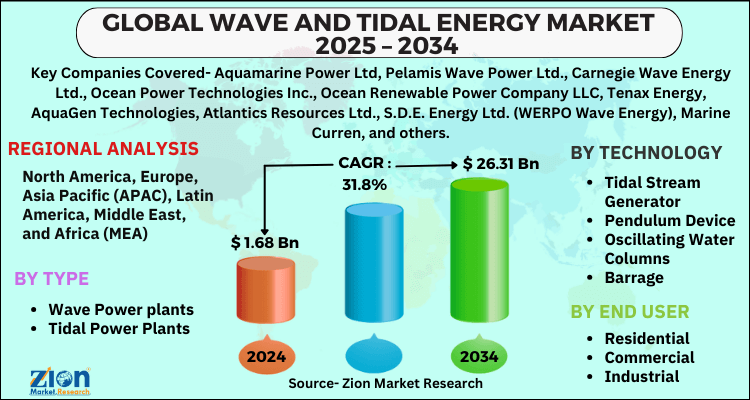Wave and Tidal Energy Market Size, Global Industry Report, 2034

Wave and Tidal Energy Market By Type (Wave Power plants and Tidal Power Plants). By Technology (Tidal Stream Generator, Pendulum Device, Oscillating Water Columns, Barrage, and Others). By End User (Residential, Commercial, and Industrial), And By Region: Global And Regional Industry Overview, Market Intelligence, Comprehensive Analysis, Historical Data, And Forecasts 2025 - 2034
| Market Size in 2024 | Market Forecast in 2034 | CAGR (in %) | Base Year |
|---|---|---|---|
| USD 1.68 Billion | USD 26.31 Billion | 31.8% | 2024 |
Wave and Tidal Energy Market Size And Forecast
The global wave and tidal energy market size was worth around USD 1.68 Billion in 2024 and is predicted to grow to around USD 26.31 Billion by 2034 with a compound annual growth rate (CAGR) of roughly 31.8% between 2025 and 2034. The report analyzes the global wave and tidal energy market's drivers, restraints/challenges, and the effect they have on the demands during the projection period. In addition, the report explores emerging opportunities in the wave and tidal energy industry.
Wave and Tidal Energy Market: Overview
Wave energy is the process of conveying and capturing energy from the ocean's surface and utilizing it for applications such as power generating. Tidal energy is generated by the interaction of the moon's and sun's gravitational forces, which causes the natural rise and fall of ocean tides or seawater levels.
The global wave and tidal energy industry are experiencing the strongest demand due to a rise in project expansion across countries, which results in substantial electricity cost reductions. Additionally, an increase in investments and new rules by local governments encourages technology innovators to commercialize their energy converter devices as soon as possible. For both energy types, technical development is still in its early stages.
This offers plenty of room for new entrants to enter the industry by offering cutting-edge technologies. There is a greater prospect for the development of new technology-based tidal stream power plants. Both private and public industries are expected to have massive market expansion in terms of installed capacity and investment. The growing use of renewable energy sources, as well as the potential of wave and tidal as power sources, are encouraging commercialization through the deployment of small arrays, which will have a positive impact on the wave and tidal energy market growth in the foreseeable future.
Key Insights
- As per the analysis shared by our research analyst, the global wave and tidal energy market is estimated to grow annually at a CAGR of around 31.8% over the forecast period (2025-2034).
- Regarding revenue, the global wave and tidal energy market size was valued at around USD 1.68 Billion in 2024 and is projected to reach USD 26.31 Billion by 2034.
- The wave and tidal energy market is projected to grow at a significant rate due to increasing demand for renewable energy sources, government support for clean energy initiatives, and advancements in technology that improve the efficiency and cost-effectiveness of wave and tidal power generation.
- Based on Type, the Wave Power plants segment is expected to lead the global market.
- On the basis of Technology, the Tidal Stream Generator segment is growing at a high rate and will continue to dominate the global market.
- Based on the End User, the Residential segment is projected to swipe the largest market share.
- Based on region, Europe is predicted to dominate the global market during the forecast period.
Wave and Tidal Energy Market: Driver
Rapid development in the renewable energy sector will propel growth.
Due to the increasing depletion of fossil fuels and rising environmental concerns, the global energy transition is advancing the renewable sector with technological advances, development priorities, and others. The government, armed with the required infrastructure resources, looks beyond the total energy supply for cost-effective and scalable alternatives.
However, in order to assess the feasibility of a new source of power, governments such as the United Kingdom have introduced clean energy growth strategies that involve cost reductions in technology, reductions in carbon emissions, and the development of cutting-edge technologies. Several technologies, including wind, solar, wave, and tidal, have been highlighted for their importance in lowering carbon emissions.
Renewable energy technologies, such as wind and solar power, have been widely adopted, however, they have limitations due to land availability and a mismatch between supply and demand. As a result, tidal and wave power have emerged as a new renewable resource with vast untapped potential. Moreover, strategic backing for the industry would result in practical implementations of the Green Transition and significant export prospects in tidal and wave power technologies.
Wave and Tidal Energy Market: Restraint
A lack of technological advancements and pricing challenges will stymie market growth.
The Wave and tidal devices technology is currently advancing to the point where wave project demonstrations are being installed. However, the technology has not yet converged with any design technology, and the research on this technology has increased the sector's complexity. As a result, a lack of industrial coherence is constrained by supply chains for diverse components of planning and technical growth. Aside from the technical barrier, the cost of constructing and preserving the structures is considerably greater than the cost of other sources of renewable energy as the operating and maintaining any facility in the open sea has many key challenges affecting the economics of scale, including the current and projected cost.
Wave and Tidal Energy Market: Report Scope
| Report Attributes | Report Details |
|---|---|
| Report Name | Wave and Tidal Energy Market |
| Market Size in 2024 | USD 1.68 Billion |
| Market Forecast in 2034 | USD 26.31 Billion |
| Growth Rate | CAGR of 31.8% |
| Number of Pages | 150 |
| Key Companies Covered | Aquamarine Power Ltd, Pelamis Wave Power Ltd., Carnegie Wave Energy Ltd., Ocean Power Technologies Inc., Ocean Renewable Power Company LLC, Tenax Energy, AquaGen Technologies, Atlantics Resources Ltd., S.D.E. Energy Ltd. (WERPO Wave Energy), Marine Curren, and others. |
| Segments Covered | By Type, By Technology, By End User, and By Region |
| Regions Covered | North America, Europe, Asia Pacific (APAC), Latin America, The Middle East and Africa (MEA) |
| Base Year | 2024 |
| Historical Year | 2020 to 2023 |
| Forecast Year | 2025 - 2034 |
| Customization Scope | Avail customized purchase options to meet your exact research needs. Request For Customization |
Wave and Tidal Energy Market: Segmentation
The Wave and Tidal Energy Market are segregated based on Type, Technology, and End User.
By Type, the market is classified into Wave Power plants and Tider Power Plants. The tidal power market has been the fastest expanding in the globe. Market expansion is being driven by increased investment in emerging markets. The most critical stage is the MeyGen project to commercialize tidal technology. Technological advancement in the tidal power segment increases commercialization, which leads to segment expansion.
By Technology, the market is classified into Tidal Stream Generator, Pendulum Device, Oscillating Water Columns, Barrage, and Others. Oscillating water columns are the most rapidly developing segment of the wave energy business. It is a form of wave energy converter that produces electrical energy. This is accomplished through the oscillation of waves within a chamber. It has a low environmental impact and is the preferred renewable energy source. Companies are working to improve the efficiency of oscillating water columns.
Recent Developments
- In 2021, Orbital Marine Power began construction on Orbital O2, the world's most powerful tidal turbine. The turbine was launched from Scotland's Port of Dundee and will be connected to the European Marine Center in Orkney, where it will be operational.
- In 2020, ABB and CorPower Ocean inked a collaboration agreement in which CorPower Ocean agreed to employ ABB's two medium voltage motors. One of them would be in charge of driving the test rig, while the other would assist in energy storage.
Wave and Tidal Energy Market: Regional Landscape
Europe is predicted to lead the market during the projection period. The increasing supply of renewable energy is obtaining a larger market share across Europe and is expected to stimulate regional industry growth. The United Kingdom has the most extensive historical deployment of this technology, and with the construction of the European Marine Energy Center, it has reached a new milestone (EMEC). Furthermore, the European Marine Energy Center (EMEC) is the largest venue for wave technology initiatives and has housed a substantial portion of wave energy developers that are nearing commercialization.
North American countries are collaborating with industry, research organizations, and government to realize prospects in marine renewable sources. Additionally, support for wave and tidal developers has grown, and the sector is steadily progressing. Moreover, the Canadian province of Nova Scotia has taken world-leading measures in building a market for tidal technology by implementing Feed-In Tariff (FIT) programs for various tidal power demonstration farms. It has drawn the attention of renowned European developers who are interested in tidal power. The large-scale implementation of these projects is likely to drive market growth during the forecast period.
Wave and Tidal Energy Market: Competitive Landscape
Some of the main competitors dominating the Wave and Tidal Energy Market include -
- Aquamarine Power Ltd
- Pelamis Wave Power Ltd.
- Carnegie Wave Energy Ltd.
- Ocean Power Technologies, Inc.
- Ocean Renewable Power Company LLC
- Tenax Energy
- AquaGen Technologies
- Atlantics Resources Ltd.
- S.D.E. Energy Ltd. (WERPO Wave Energy)
- Marine Current Turbines Ltd.
Wave and Tidal Energy Market is segmented as follows:
By Type
- Wave Power plants
- Tidal Power Plants
By Technology
- Tidal Stream Generator
- Pendulum Device
- Oscillating Water Columns
- Barrage
- Others
By End User
- Residential
- Commercial
- Industrial
By Region
- North America
- The U.S.
- Canada
- Mexico
- Europe
- France
- The UK
- Spain
- Germany
- Italy
- Rest of Europe
- Asia Pacific
- China
- Japan
- India
- Australia
- South Korea
- Rest of Asia Pacific
- The Middle East & Africa
- Saudi Arabia
- UAE
- Egypt
- Kuwait
- South Africa
- Rest of the Middle East & Africa
- Latin America
- Brazil
- Argentina
- Rest of Latin America
Table Of Content
Methodology
FrequentlyAsked Questions
The global wave and tidal energy market is expected to grow due to rising investments in marine energy projects, increasing demand for renewable energy, growing government support through policies and subsidies, and advancements in wave and tidal energy conversion technologies.
According to a study, the global wave and tidal energy market size was worth around USD 1.68 Billion in 2024 and is expected to reach USD 26.31 Billion by 2034.
The global wave and tidal energy market is expected to grow at a CAGR of 31.8% during the forecast period.
Europe is expected to dominate the wave and tidal energy market over the forecast period.
Leading players in the global wave and tidal energy market include Aquamarine Power Ltd, Pelamis Wave Power Ltd., Carnegie Wave Energy Ltd., Ocean Power Technologies Inc., Ocean Renewable Power Company LLC, Tenax Energy, AquaGen Technologies, Atlantics Resources Ltd., S.D.E. Energy Ltd. (WERPO Wave Energy), Marine Curren, among others.
The report explores crucial aspects of the wave and tidal energy market, including a detailed discussion of existing growth factors and restraints, while also examining future growth opportunities and challenges that impact the market.
RelatedNews
HappyClients
Zion Market Research
Tel: +1 (302) 444-0166
USA/Canada Toll Free No.+1 (855) 465-4651
3rd Floor,
Mrunal Paradise, Opp Maharaja Hotel,
Pimple Gurav, Pune 411061,
Maharashtra, India
Phone No +91 7768 006 007, +91 7768 006 008
US OFFICE NO +1 (302) 444-0166
US/CAN TOLL FREE +1 (855) 465-4651
Email: sales@zionmarketresearch.com
We have secured system to process your transaction.
Our support available to help you 24 hours a day, five days a week.
Monday - Friday: 9AM - 6PM
Saturday - Sunday: Closed






